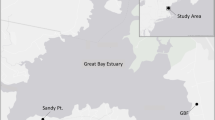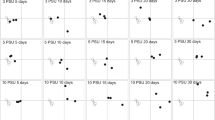Abstract
The response of deltaic emergent marsh vegetation to increases in precipitation was examined over a 14-mo period at three sites in the lower Nueces Estuary in south Texas. At all three sites, significant changes in plant biomass, percent cover, and allocation of aboveground and belowground tissues were associated with more than double the rainfall in late winter and early spring 1992 compared to the previous year and the 50-yr average for this region. Water column salinities, which ranged from 10‰ to 35‰ at all three sites in 1991, remained below 10‰ through August 1992. Significant changes in marsh vegetative structure included decreases in bare space, increases in the percent cover and aboveground biomass of a relatively less salt tolerant halophytes (Borrichia frutescens), and significant increases in root:shoot ratios inB. frutescens, Batis maritima andSuaeda linearis (inSalicornia virginica root:shoot ratios decreased significantly). Higher precipitation generally led to an overall increase in the biomass of most marsh perennials, but these increases were not statistically significant. For one species,Lycium carolinianum, additional rainfall extended its growing season through August 1992, 2 mo longer than in the previous year. The expansion (+58%) ofB. frutescens at one site was also coincident with the significant loss ofB. maritima, whose cover decreased nearly 20%. In an ecological context, these responses suggest that precipitation events in arid environments may be considered a major physical disturbance that can result in large changes in the composition and relative abundance of emergent vascular plants over a relatively short period. The long-term significance of these changes is unknown and demonstrates the value of ecological studies that are conducted over several years for a more complete understanding of the dynamic processes that regulate marsh productivity.
Similar content being viewed by others
Literature Cited
Adam, P. 1990. Saltmarsh Ecology. Cambridge University Press, Cambridge, Maryland.
Adams, D. A. 1963. Factors influencing vascular plant zonation in North Carolina salt marshes.Ecology 44:445–456.
Alexander, H. D. 2000. Effects of soil salinity, inorganic nitrogen and freshwater inflow on the vegetation of a hypersaline salt marsh. M.S. Thesis, The University of Texas at Austin, Austin, Texas.
Armstrong, N. E. 1987. The ecology of open-bay bottoms of Texas: A community profile. U.S. Fish Wildlife Service, Biology Report 85:104, Washington, D.C.
Baumann, R., J. Day andC. Miller. 1984. Mississippi deltaic wetland survival; sedimentation vs. coastal submergence.Science 222:1093–1095.
Bertness, M. D. 1991. Interspecific interactions among high marsh perennials in a New England salt marsh.Ecology 72: 125–137.
Bertness, M. D. andA. M. Ellison. 1987. Determinants of pattern in a New England salt marsh plant community.Ecological Monographs 57:129–147.
Bertness, M. D., L. Gough andS. W. Shumway. 1992. Salt tolerances and the distribution of fugitive salt marsh plants.Ecology 73:1842–1851.
Blom, C. W. P. M. andL. A. C. J. Voesenek. 1996. Flooding: The survival strategies of plants.Trends in Ecology and Evolution 11:290–295.
Bureau of Reclamation. 2000. Concluding report: Rincon Bayou demonstration project. Volume I: Executive summary. U.S. Department of the Interior, Bureau of Reclamation, Oklahoma-Texas Area Office, Austin, Texas.
Clarke, L. D. andN. J. Hannon. 1970. The mangrove swamp and salt marsh communities of the Sydney district III. Plant growth in relation to salinity and waterlogging.Journal of Ecology 56:351–369.
da Cunha Lana, P., C. Guiss, andS. T. Disaro. 1991. Seasonal variation of biomass and production dynamics for above and belowground components of aSpartina alterniflora marsh in the euhaline sector of Paranagua Bay (SE Brazil).Estuarine, Coastal and Shelf Science 32:231–241.
Dahl, T. E. andC. E. Johnson. 1991. Status and trends of wetlands in the conterminous United States, mid-1970’s to mid-1980’s. U.S. Department of Interior, Fish and Wildlife Service, Washington, D.C.
Dame, R. F. andP. D. Kenny. 1986. Variability ofSpartina alterniflora primary production in the euhaline North Inlet estuary.Marine Ecology Press Series 32:71–80.
Espey, Huston andAssociates, Inc. 1977. Marsh plant production and potential detritus in Lavaca, San Antonio, and Nueces Bays. Document Number: 7688. Texas Department of Water Resources, Austin, Texas.
Espey, Huston andAssociates, Inc. 1981. Nueces marsh development: A feasibility study of the introduction of river flows. Document #81328. Espey, Huston and Associates, Inc. Austin, Texas.
Gallagher, J. L. andF. G. Plumley. 1979. Underground biomass profiles and productivity in Atlantic coastal marshes.American Journal of Botany 66:156–161.
Good, R. E., N. F. Good andB. R. Frasco. 1982. A review of primary production and decomposition dynamics of the belowground marsh component, p. 139–157.In V. Kennedy (ed.), Estuarine Comparisons. Academic Press, New York.
Gross, M. F., M. A. Hardisky, andV. Klemas. 1990. Inter-annual spatial variability in the response ofSpartina alterniflora biomass to amount of precipitation.Journal of Coastal Research 6: 949–960.
Gross, M. F., M. A. Hardisky, P. L. Wolf, andV. Klemas. 1991. Relationship between aboveground and belowground biomass ofSpartina alterniflora (smooth cordgrass).Estuaries 14: 180–191.
Hacker, S. D. andM. D. Bertness. 1995. Morphological and physiological consequences of a positive plant interaction.Ecology 76:2165–2175.
Haines, B. L. andE. L. Dunn. 1976. Growth and resource allocation response ofSpartina alterniflora Loisel to three levels of NH4-N, Fe, and NaCl in solution culture.Botany Gazette 137: 224–230.
Heilman, J. L., D. R. Cobos, F. A. Heinsch, C. S. Campbell, andK. J. McInnes. 1999. Tower-based conditional sampling for measuring ecosystem-scale carbon dioxide exchange in coastal wetlands.Estuaries 22:584–591.
Henningson, Durham and Richardson, Inc. and North Texas State University. 1978. Studies of freshwater needs of fish and wildlife resources in the Nueces-Corpus Christi Bay area, Texas. Technical Report to U.S. Fish and Wildlife Service, Austin, Texas.
Kuhn, N. L. andJ. B. Zedler. 1997. Differential effects of salinity and soil saturation on native and exotic plants of a coastal salt marsh.Estuaries 20:391–403.
Lee, K.-S. andK. H. Dunton. 1999. Inorganic nitrogen acquisition in the seagrassThalassia testudinum: Development of a whole-plant nitrogen budget.Limnology and Oceanography 44: 1204–1215.
Lee, K.-S. andK. H. Dunton. 2000. Effects of nitrogen enrichment on biomass allocation, growth, and leaf morphology of the seagrassThalassia testudinum.Marine Ecology Progress Series 196:39–48.
Longley, W. L. (ed.). 1994. Freshwater inflows to Texas bays and estuaries: Ecological relationships and methods for determination of needs. Texas Water Development Board and Texas Parks and Wildlife Department, Austin, Texas.
Lott, N. andT. Ross. 1997. U.S. monthly precipitation data for cooperative and NWS sites (station 412015, Corpus Christi International Airport). National Climatic Data Center Research Customer Service Group, National Oceanic and Atmospheric Administration. Asheville, North Carolina.
Mitsch, W. J. andJ. G. Gosselink. 1986. Wetlands. Van Nostrand Reinhold Company, New York.
Morton, R. A. andJ. G. Paine. 1984. Historical shoreline changes in Corpus Christi, Oso and Nueces bays, Texas Gulf coast. Geological Circular 84-6. Bureau of Economic Geology, University of Texas, Austin, Texas.
Naidoo, G. andS. G. Mundree. 1993. Relationship between morphological and physiological responses to waterlogging and salinity inSporobolus virginicus (L.) Kunth.Oecologia 93: 360–366.
Parrondo, R. T., J. G. Gosselink, andC. S. Hopkinson. 1978. Effects of salinity and drainage on the growth of three small marsh grasses.Botanical Gazette 139:102–107.
Parsons, T. R., Y. Maita, andC. M. Lalli. 1984. A Manual of Chemical and Biological Methods for Seawater Analysis. Pergamon Press, New York.
Pearcy, R. W. andS. L. Ustin. 1984. Effects of salinity on growth and photosynthesis of three California tidal marsh species.Oecologia 62:68–73.
Pezeshki, S. R., R. D. Delaune, andC. W. Lindau. 1988. Interaction among sediment anaerobiosis, nitrogen uptake and photosynthesis ofSpartina alterniflora.Physiologia Plantarum 74: 561–565.
Ruth, B. F. 1990. Establishment of estuarine faunal use in a salt marsh creation project, Nueces River Delta, Texas. CCSU-9001-CCS. Center for Coastal Studies, Corpus Christi State University, Corpus Christi, Texas.
SAS Institute, Inc. 1995. SAS Statistical Package. Version 6. SAS Institute, Cary, North Carolina.
Shumway, S. W. andM. D. Bertness. 1992. Salt stress limitation of seedling recruitment in a salt marsh plant community.Oecologia 92:490–497.
Shumway, S. W. andM. D. Bertness. 1994. Patch size effects on marsh plant secondary succession mechanisms.Ecology 75: 564–568.
Smart, R. M. andJ. W. Barko. 1980. Nitrogen nutrition and salinity tolerance ofDistichlis spicata andSpartina alterniflora.Ecology 61:630–638.
Solis, R. S. 1994. Patterns of inflow and salinity, p. 386:23–40.In W. L. Longley (ed.), Freshwater Inflows to Texas Bays and Estuaries: Ecological Relationships and Methods for Determination of Needs. Legislative Report by the Texas Water Development Board and the Texas Parks and Wildlife Department, Austin, Texas.
Tolley, P. M. andR. R. Christian. 1999. Effects of increased inudation and wrack deposition on a high salt marsh plant community.Estuaries 22:944–954.
Valiela, I., J. M. Teal, S. Volkman, D. Shafer, andE. J. Carpenter. 1978. Nutrients and particulate fluxes in a salt water march ecosystem: Tidal exchanges and inputs by precipitation and ground water.Limnology and Oceanography 23:798–812.
Van Tussenbroek, B. I. 1997. Above- and below-ground biomass and production byThalassia testudinum in a tropical reef lagoon.Aquatic Botany 61:69–82.
Ward, Jr.,G. H. 1985. Marsh enhancement by freshwater diversion.Journal of Water Resources Planning and Management 111:1–23.
Weilhoefer, L. C. 1998. Effects of freshwater inflow, salinity and nutrients on salt marsh vegetation in south Texas. M.S. Thesis, The University of Texas at Austin, Austin, Texas.
White, W. A. andT. R. Calnan. 1990. Sedimentation and historical changes in fluvial-deltaic wetlands along the Texas Gulf coast with emphasis on the Colorado and Trinity river deltas. Report to Texas Parks and Wildlife Department by Bureau of Economic Geology, University of Texas at Austin, Austin, Texas.
White, W. A., T. R. Calnan, R. A. Morton, R. S. Kimble, T. G. Littleton, J. H. McGowen, H. S. Nance, andK. E. Schmedes. 1983. Submerged lands of Texas, Corpus Christi areas: Sediments, geochemistry, benthic macroinvertebrates, and associated wetlands. Bureau of Economic Geology, University of Texas at Austin, Austin, Texas.
Wilcox, D. P. andW. M. Childress. 1981. Nutrient flux between the Nueces deltaic marsh and the Nueces estuary on the Texas Gulf Coast, p. 472–488.In R. D. Cross and D. L. Williams (eds.), Proceedings of the National Wetlands Symposium on Freshwater Inflows to Estuaries. Biological Services Program. EWS/OBS-81-04. Department of Interior, Washington, D.C.
Zedler, J. B. 1977. Salt marsh community structure in the Tijuana Estuary, California.Estuarine and Coastal Marine Science 5:39–53.
Zedler, J. B. andP. A. Beare. 1986. Temporal variability of salt marsh vegetation: The role of low-salinity gaps and environmental stress, p. 295–306.In D. Wolfe (ed.), Estuarine Variability. Academic Press, New York.
Author information
Authors and Affiliations
Corresponding author
Rights and permissions
About this article
Cite this article
Dunton, K.H., Hardegree, B. & Whitledge, T.E. Response of estuarine marsh vegetation to interannual variations in precipitation. Estuaries 24, 851–861 (2001). https://doi.org/10.2307/1353176
Received:
Accepted:
Issue Date:
DOI: https://doi.org/10.2307/1353176




